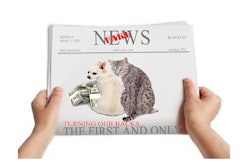
While the U.S. pet food market reached US$36 billion in sales in 2019, representing a healthy 7.3% gain, not all categories and channels reaped the benefits. According to Maria Lange, vice president of strategic verticals pet and cannabis for Nielsen, there were winners and losers:
Winner 1: e-commerce. Unsurprisingly, 65% of growth was driven by this channel, as it increased 28.5%, hit US$5.8 billion in pet food sales and accounted for 16% of the pet food market. The largest channel for pet food in 2019, at 44%, was mainstream retail – grocery and mass market stores – which saw sales of US$15.8 billion, growing 6.7% year-over-year (YOY).
Winner 2: “fresh” pet food. Partially freeze-dried and dehydrated products accounted for 9% of the dry pet food market in 2017; that share rose to 13.1% in 2019, with sales soaring 39%. “Kibble plus” pet foods reached US$7.3 million in 2019 in the mass channel, despite the average store carrying only two items. On the wet side, frozen pet foods’ share increased from 11.9% in 2017 to 17.6% in 2019.
Winner 3: private label pet food. In the overall U.S. pet food market, private label products reached US$2.2 billion in sales last year, Lange said. In the pet specialty channel, these products’ sales have soared 75% since 2017 and 19% in 2019 alone.
Loser 1: grain-free pet food. Again, no surprise here – or that the category’s decline can be directly tied to the Food and Drug Administration’s announcements over its investigation into canine dilated cardiomyopathy. For the first half of 2018, the category was still increasing at 8.4% YOY in pet specialty; by the end of 2019, the category had decreased 5.9% in that channel. Comparatively, the overall U.S. market experienced slight growth of 3% for grain-free in 2019.
Loser 2: pet specialty retail. Due to the grain-free slide and growth of e-commerce, this was the lone channel seeing a decline in 2019, of 1.5%, ending at US$8.3 billion sales and 23% of the market.
Loser 3: traditional dry pet food. With newer pet food formats rising, the overall dry category declined by 4.9% YOY in 2019, mainly from a 9.2% drop in traditional dry pet food sales. However, that category still dominates, accounting for nearly 87% of the dry market.
















